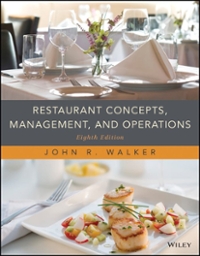Question
In recent years, the airline industry becomes increasingly competitive. Since being deregulated during the 1970s in the United States, long established airlines such as Pan
In recent years, the airline industry becomes increasingly competitive. Since being deregulated during the 1970s in the United States, long established airlines such as Pan American and Eastern have gone out of business as new upstarts like Midwest Express and Southwest have successfully entered the market. It appeared that almost anyone could buy a few used planes to serve the smaller cities that the larger airlines no longer wanted to serve. These low-cost small-capacity commuter planes were able to make healthy profits in these markets where it was too expensive to land large jets. Rail and bus transportation either did not exist or was undesirable in many locations. Eventually the low-cost local commuter airlines expanded services to major cities and grabbed market share from the majors by offering cheaper fares with no frill's services. In order to be competitive with these lower cost upstarts, United Airlines and Northwest Airlines offered stock in the company and seats on the Board of Directors to their unionized employees in exchange for wages and benefits reductions. Delta and American Airlines, among other major carriers, reduced their costs by instituting a cap on travel agent commissions. Travel agencies were livid at this cut in their livelihood, but they needed the airlines' business in order to offer customers a total travel package.
Globally it seemed as though every nation had to have its own airline for national prestige. These state-owned airlines were expensive, but the governments subsidized them with money and supporting regulations. For example, a foreign airline was normally allowed to fly only into one of a country's airports, forcing travelers to switch to the national airline to go to other cities. During the 1990s and 2000s, many countries began privatizing their national airlines as governments tried to improve their budgets, to be viable in an alliance and even purchase an airline in another country or region. For example, the Dutch KLM Airline acquired half interest in the U.S Northwest Airlines in order to obtain not only U.S destinations, but also Northwest's Asian travel routes, thus making it one of the few global airlines.
Costs were still relatively high of the worlds' major airlines because of the high cost of new airlines, just a one new jet plane costs anywhere from $50 million to $200million and more. By 2011, only two airplane manufacturers provided almost all of the large commercial airliners: Boeing and Airbus. Major airlines were forced to purchase new planes because they were more fuel efficient, safer, and easier to maintain. Airlines that choose to stay with an older fleet of planes had to deal with higher fuel and maintenance costs, factors that often made it cheaper to buy new planes.
Company X (Foreign large airline company) is planning to launch a new market in USA, for doing so, CEO assign an urgent task to your department, using Porter's approach to industry analysis answer the following questions:
- According to the above information, evaluate the threat of rivalry in the Airline industry, is it high, low, or moderateandwhy?
- Critically analyzethethreatofsuppliersintheAirline industry, isithigh, lowormoderateandwhy?
- If Company X were to open its own business in the small cities in USA, Critically discuss which type ofstrategy will be adopted by the company and the reasons for choosing this strategy?
Step by Step Solution
There are 3 Steps involved in it
Step: 1

Get Instant Access to Expert-Tailored Solutions
See step-by-step solutions with expert insights and AI powered tools for academic success
Step: 2

Step: 3

Ace Your Homework with AI
Get the answers you need in no time with our AI-driven, step-by-step assistance
Get Started


